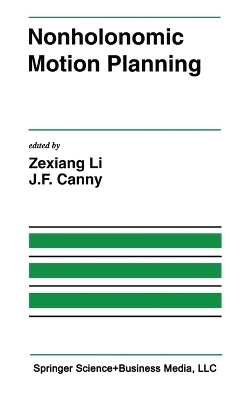
Nonholonomic Motion Planning
Kluwer Academic Publishers (Verlag)
978-0-7923-9275-0 (ISBN)
"Nonholonomic Motion Planning" grew out of the Workshop on Nonholonomic Motion Planning that took place at the 1991 IEEE International Conference on Robotics and Automation. It consists of contributed chapters representing new developments in this area. Contributors to the book include robotics engineers, nonlinear control experts, differential geometres and applied mathematics. The book is arranged around three chapter groups: controllability - one of the key mathematical tools needed to study nonholonomic motion; motion planning for mobile robots - focusing on problems with nonholonomic velocity constraints as well as constraints on the generalized co-ordinates; and falling cats, space robots and gauge theory. There are numerous connections to be made between symplectic geometry techniques for the study of holonomies in mechanics, gauge theory and control. In this section these connections are discussed using the backdrop of examples drawn from space robots and falling cats reorienting themselves.
"Nonholonomic Motion Planning" can be used either as a reference for researchers working in the areas of robotics, nonlinear control and differential geometry, or as a textbook for a graduate level robotics or nonlinear control course.
Nonholonomic kinematics and the role of elliptic functions in constructive controllability, R.W. Brockett and L. Dai; steering nonholonomic control systems using sinusoids, R.M. Murray and S. Shakar Sastry; smooth time-periodic feedback solutions for nonholonomic motion planning, L. Gurvits and Zexiang Li; lie bracket extensions and averaging - the single-bracket case, H.J. Sussmann and Wensheng Liu; singularities and topological aspects in nonholonomic motion planning, J.-P. Laumond; motion planning for nonholonomic dynamic systems, M. Reyhanoglu et al; a differential geometric approach to motion planning, G. Lafferriere and H.J. Sussmann; planning smooth paths for mobile robots, P. Jacobs and J. Canny; nonholonomic control and gauge theory, R. Montgomery; optimal nonholonomic motion planning for a falling cat, C. Fernandes et al; nonholonomic behaviour in free-floating space manipulators and its utilization, E.G. Papadopoulos.
| Erscheint lt. Verlag | 31.10.1992 |
|---|---|
| Reihe/Serie | The Springer International Series in Engineering and Computer Science ; v. 192 |
| Zusatzinfo | index |
| Sprache | englisch |
| Einbandart | gebunden |
| Themenwelt | Informatik ► Theorie / Studium ► Künstliche Intelligenz / Robotik |
| Technik ► Elektrotechnik / Energietechnik | |
| ISBN-10 | 0-7923-9275-2 / 0792392752 |
| ISBN-13 | 978-0-7923-9275-0 / 9780792392750 |
| Zustand | Neuware |
| Informationen gemäß Produktsicherheitsverordnung (GPSR) | |
| Haben Sie eine Frage zum Produkt? |
aus dem Bereich


